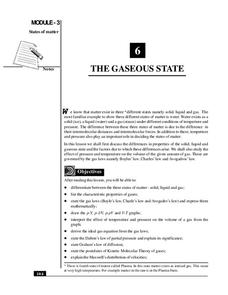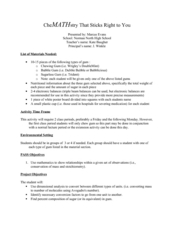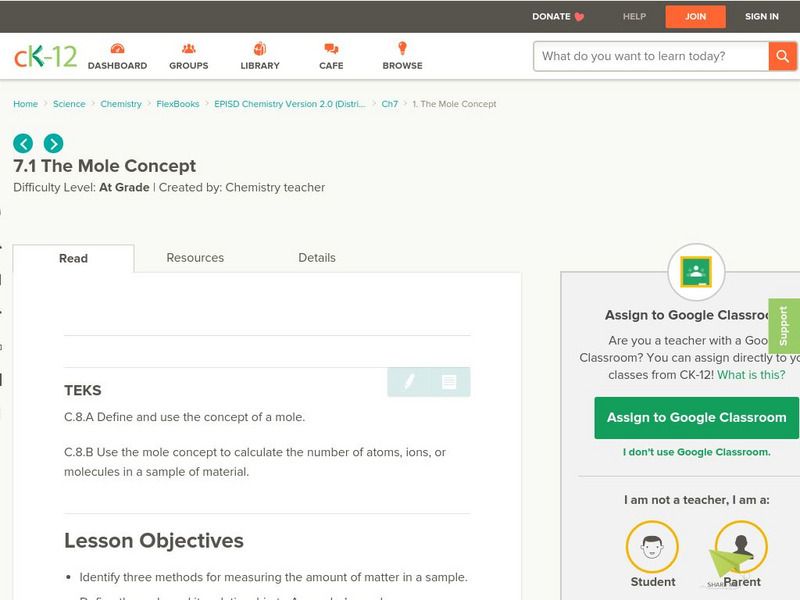Curated OER
Ammonium Nitrate - Efficient Fertilizers
Students study the chemistry of ammonium nitrate and consider the advantages and disadvantages of this compound. They compare different fertilizers and calculate the molar mass and percent nitrogen in the different fertilizers.
National Institute of Open Schooling
The Gaseous State
Sixth in a series of 36, this lesson focuses on gases and their behavior in given situations. Learners review the states of matter and then focus on gases, specifically learning Boyle's, Charles's, Avogadro's Laws, Dalton's, and Graham's...
Curated OER
CheMATHstry That Sticks Right to You
Students find the percent composition of sugar in the gum. In this chemistry lesson, students calculate percent error from the experiment. They use dimensional analysis to convert between units.
Curated OER
Stoichiometry
Balancing equations is a foundational skill for starting chemists. There are a few slides in this PowerPoint with colorful diagrams that help to explain how. Unfortunately, the presentation begins with an unrelated table of contents and...
Curated OER
The Ideal Gas law, Molar Mass and Density
In this ideal gas law, molar mass and density learning exercise, students read about how the molar mass and density of a gas can be determined from the ideal gas law. They solve five problems using the ideal gas law to find the pressure,...
Curated OER
Moles Worksheet
In this chemistry worksheet, students identify and write how many significant figures they would use for each problem. Then they round the answers to the appropriate number of significant figures. Finally, students calculate the mass of...
Virginia Department of Education
Charles’ Law
Searching for a relatively interesting way to demonstrate Charles' Law? Here is a instructional activity in which pupils heat air inside a flask and then cool the flask to quickly cool the air. They make observations about what occurs...
Virginia Department of Education
States of Matter
Scientists have been studying exothermic reactions before they were cool. The lesson begins with a discussion and a demonstration of heat curves. Scholars then determine the heat of fusion of ice and the heat needed to boil water through...
Virginia Department of Education
Aspirin Analysis
Laughter may be the best medicine, but aspirin is also important. Young chemists analyze aspirin tablets using titration in this lab experiment. They then repeat the entire experiment using a different aspirin brand.
Curated OER
Gas Stoichiometry
In this gas stoichiometry worksheet, students use the ideal gas law and balanced chemical equations to solve for unknown values such as volume and mass of gases.
Curated OER
Stoichiometry
In this stoichiometry worksheet, students identify types of reactions, show the products, and balance the equations. Students determine the limiting reagent, theoretical yield, and percent yield for given reactions. This worksheet has 5...
Curated OER
From Molecules to Mole Day Do's
Students recognize methods used to define the mole. After converting various quantities to the mole, students provide a context for understanding the usefulness of scientific notation and the mole.
TED Talks
Ted: Ted Ed: How Big Is a Mole? (Not the Animal, the Other One.)
Video describes how moles are used in chemistry and how their size is measured. [4:33] Followed by a short quiz and a list of additional resources to explore.
Other
Chris Johnson: Amedeo Avogadro
This site deals with Amedeo Avogadro, his life, his contributions to chemistry, and his famous number.
Chiral Publishing
Chiral Publishing: An Introduction to Chemistry: Relating Mass to Number of Particles: Audio Book
This slide and audio book shows how to relate mass to a number of particles by using many formulas, examples, and real life scenarios. View the weighted average calculations, Avogadro's number, the atomic mass of carbon, and molar mass.
Other
The Catalyst Chemistry Resources for Teachers
This site directs teachers to relevant information for use in the teaching of chemistry. The site's content includes projects, demos, labs and activities, and more.
CK-12 Foundation
Ck 12: Chemistry Simulation: Mole Carnival
[Free Registration/Login Required] In the mole carnival, students count the number of atoms and particles in different objects found at the carnival. As students work to find the number of particles, they practice counting particles by...
Cosmo Learning
Cosmo Learning: Junior Chemistry With Chemguy
A collection of video lectures to teach junior high students topics in chemistry. Lectures cover topics in understanding the periodic table, compounds, chemical bonding, Avogadro's number, balancing chemical equations, stoichiometry,...
Chiral Publishing
Chiral Publishing: An Introduction to Chemistry: Avogadro's Law: Volume Number of Particles
Animation depicting Avogadro's Law or how the volume of a gas is affected by the number of gas particles. See what happens to the volume of a gas when the pressure and temperature stay constant.
CK-12 Foundation
Ck 12: The Mole Concept
[Free Registration/Login may be required to access all resource tools.] In the following online tutorial students will identify three methods for measuring the amount of matter in a sample. They will define the mole and its relationship...
Georgia Department of Education
Ga Virtual Learning: Chemistry: Gas Laws
Through informational text, interactive practice problems, virtual simulations, and video clips, students learn about the gas laws.
Iowa State University
Iowa State University: Argument for Scientific Realism
This page from Iowa State University describes the various experimental ways that Avogadro's number has been determined.
Other
Lock Haven: Glossary of Frequently Misused or Misunderstood Physics Terms
A page, written by Donald E. Simanek of Lock Haven University discusses misused and misunderstood physics terms and concepts. It reminds us that Avogadro's number is a constant, and should be treated as such.
Vision Learning
Visionlearning: Atomic Theory and Structure: The Mole: Its History and Use
An introduction to the mole, a unit of measurement that quantifies atoms and molecules.





















